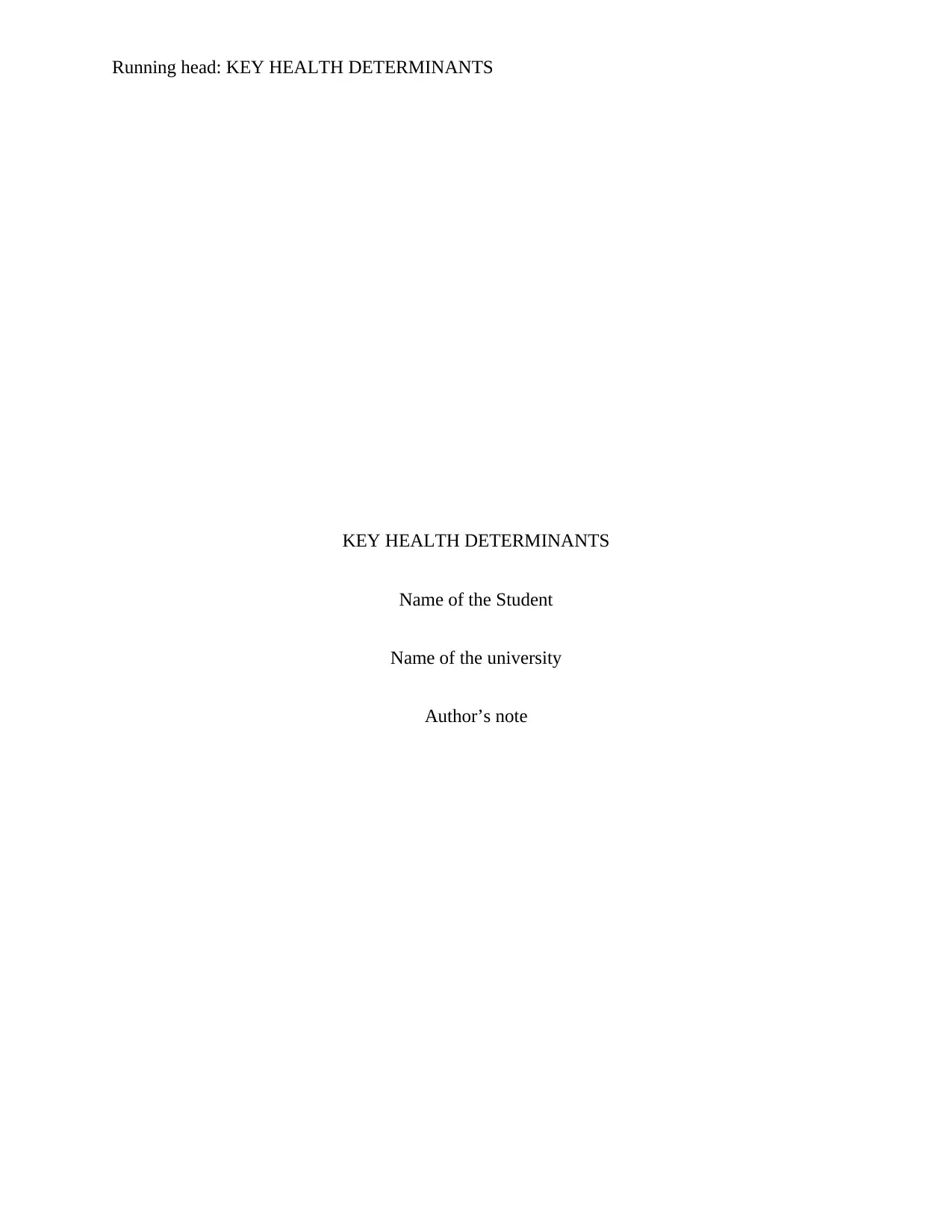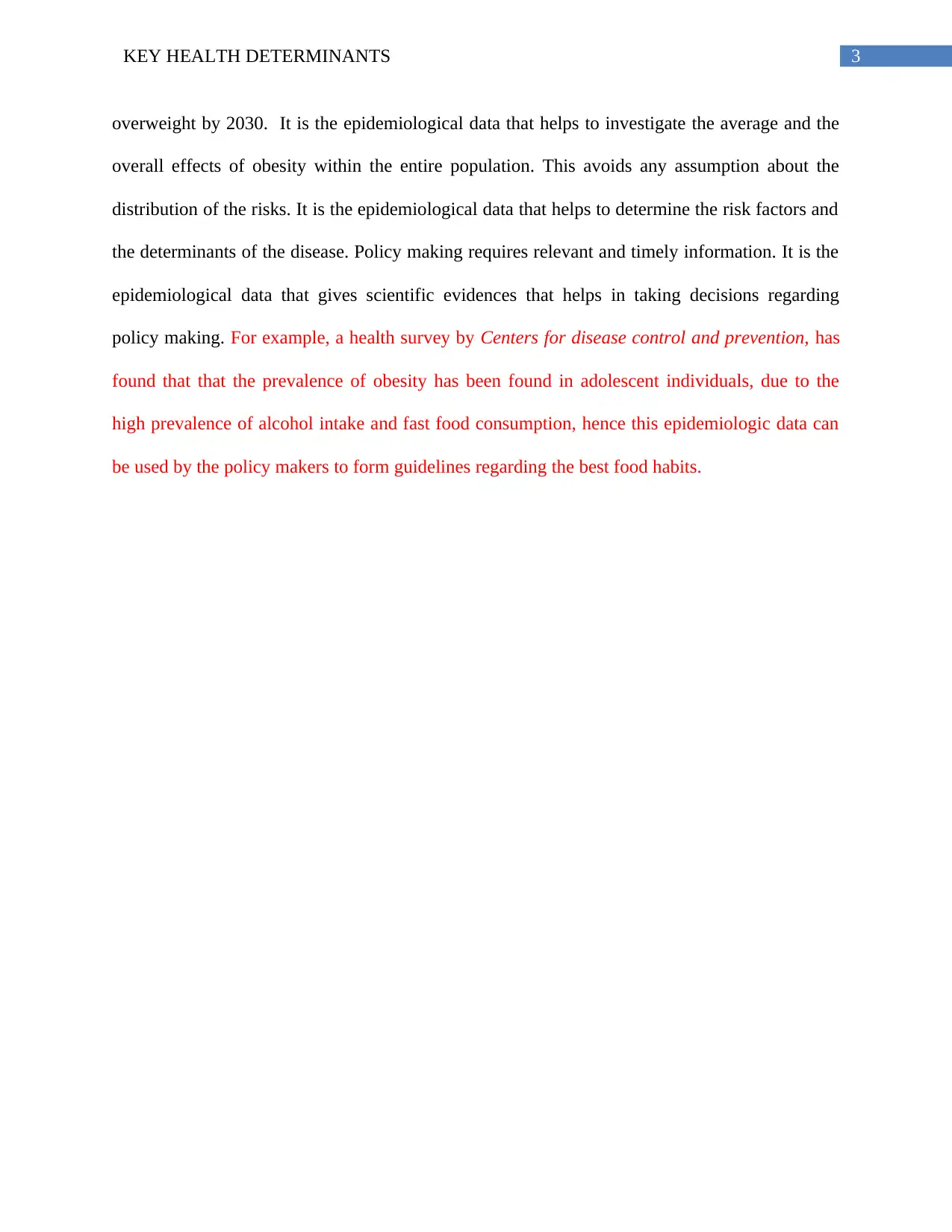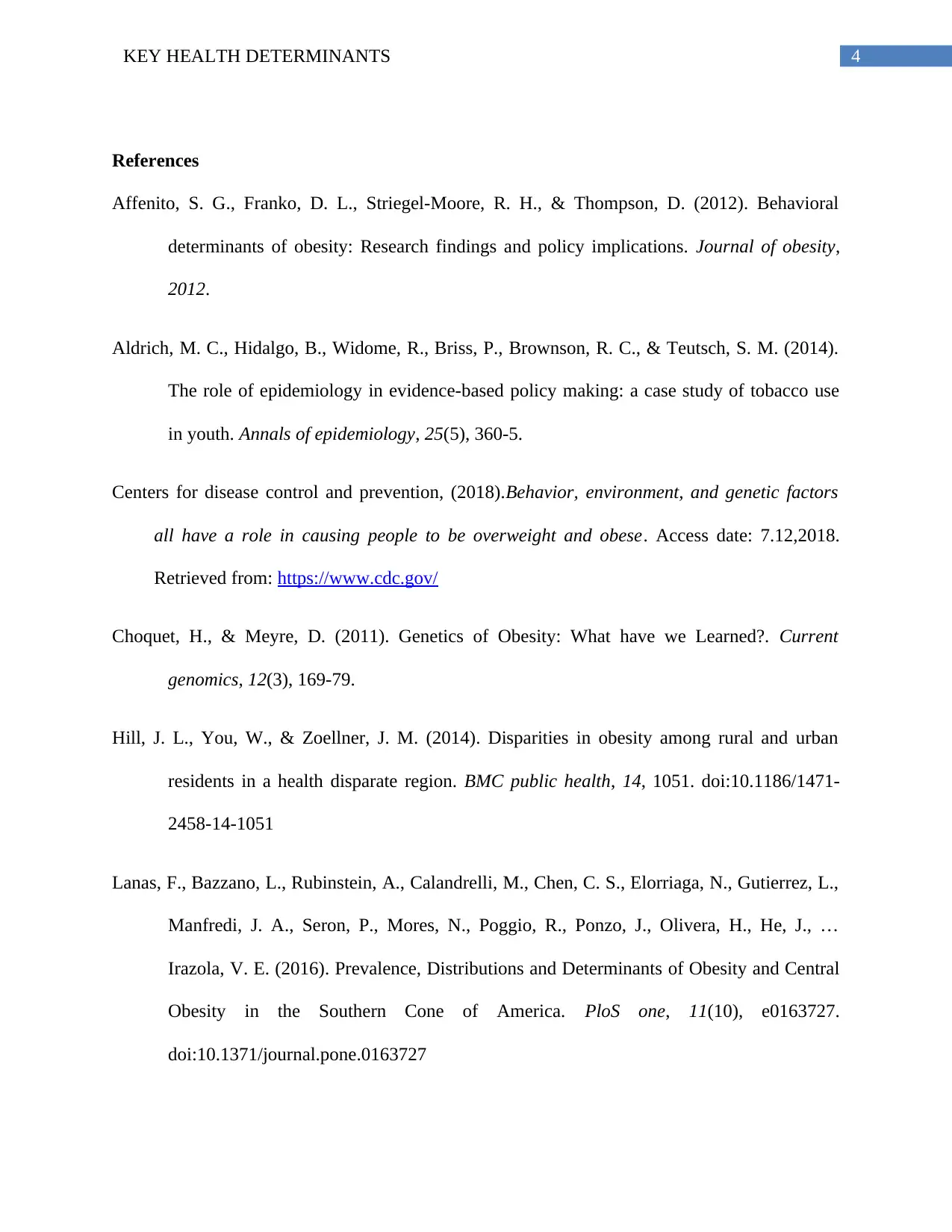University Assignment: Key Health Determinants and Obesity Discussion
VerifiedAdded on 2023/05/28
|6
|1083
|448
Discussion Board Post
AI Summary
This discussion post examines key health determinants contributing to obesity in the United States, referencing a framework by Kindig, Asada, and Booske (2008). The assignment analyzes factors such as access to healthcare, social and physical environments, individual behaviors, and genetics. The student argues that individual behavior is the most significant determinant, highlighting unhealthy food choices and lifestyle. The post also emphasizes the importance of epidemiological data in understanding the prevalence of obesity and making informed policy decisions. Various studies and statistics are referenced to support the arguments, offering a comprehensive overview of the complexities surrounding obesity and its determinants. The solution is contributed by a student to Desklib, a platform for AI-powered study tools.

Running head: KEY HEALTH DETERMINANTS
KEY HEALTH DETERMINANTS
Name of the Student
Name of the university
Author’s note
KEY HEALTH DETERMINANTS
Name of the Student
Name of the university
Author’s note
Paraphrase This Document
Need a fresh take? Get an instant paraphrase of this document with our AI Paraphraser

1KEY HEALTH DETERMINANTS
Key health determinants
Obesity is a common metabolic disease prevalent in United States. It affected about 93.3
million of the adult population in US. The estimated annual cost of obesity in US has been found
to be about $147 billion in the year 2017 (Centers for disease control and prevention, 2018). The
medical costs for obese people are about $147 billion higher than that of the normal people.
Obesity increases the risk of cardiovascular diseases, stroke, type 2 diabetes, stroke and many
other clinical conditions leading to premature and preventable deaths.
Determinants of obesity problem in United States
Access to health care
People living in the rural areas or those belonging to low socioeconomic status might not
get access to effective primary strategies for obesity prevention. Unavailability of proper
dieticians of nutritionists for making assisting to make a proper diet plan and exercise regimen
might be an important factor behind obesity problems (Hill, You & Zoellner, 2014).
Social environment
Socio-economic status can be an important determinant of obesity as people suffering
from poverty are likely to consume unhealthy fast food as they night not afford healthy and
nutritious, fresh foods (Suglia et al., 2016). Other factors like the increased portion sizes,
proliferation of the fast food chain are also contributing to obesity problems.
Individual behavior
The behavioral influences on the intake of energy and energy expenditure is also
important. Obesity promoting individual behaviors like frequent consumption of the fast food,
Key health determinants
Obesity is a common metabolic disease prevalent in United States. It affected about 93.3
million of the adult population in US. The estimated annual cost of obesity in US has been found
to be about $147 billion in the year 2017 (Centers for disease control and prevention, 2018). The
medical costs for obese people are about $147 billion higher than that of the normal people.
Obesity increases the risk of cardiovascular diseases, stroke, type 2 diabetes, stroke and many
other clinical conditions leading to premature and preventable deaths.
Determinants of obesity problem in United States
Access to health care
People living in the rural areas or those belonging to low socioeconomic status might not
get access to effective primary strategies for obesity prevention. Unavailability of proper
dieticians of nutritionists for making assisting to make a proper diet plan and exercise regimen
might be an important factor behind obesity problems (Hill, You & Zoellner, 2014).
Social environment
Socio-economic status can be an important determinant of obesity as people suffering
from poverty are likely to consume unhealthy fast food as they night not afford healthy and
nutritious, fresh foods (Suglia et al., 2016). Other factors like the increased portion sizes,
proliferation of the fast food chain are also contributing to obesity problems.
Individual behavior
The behavioral influences on the intake of energy and energy expenditure is also
important. Obesity promoting individual behaviors like frequent consumption of the fast food,

2KEY HEALTH DETERMINANTS
adopting a sedentary life style, high consumption of sweetened beverages, skipping of breakfast,
large portion sizes and intentional lack of physical exercises contributes to obesity (Affenito et
al., 2012).
Physical environment
Physical environmental factors such as the overcrowding, lack of proper space, lack of
playgrounds and parks can contribute to obesity. Adults and children cannot practice exercises or
physical activities due to lack of spaces.
Genetics
There are studies that have provided evidence about the different genetic variants that
might contribute to obesity by increasing the food intake. According to Choquet and Meyre,
(2011), defects in eight genes involved in the neuronal differentiation in the leptin pathway have
been found to be linked to monogenic obesity. Most of the literary evidences suggests that it is
the dietary habits that interacts with the genes fir modulating the predisposition to obesity.
Amongst all the determinants I believe that it is the individual behavior, which is the
most important determinant of obesity. Lack of awareness among the adolescents about the
correct choice of food, easy availability of take-away food, large number of fast food restaurants
are provoking people against unhealthy life choices. Unhealthy choices of food is always not
guided by socio-economic status, but also upon individual choices.
Epidemiological data
A large number of epidemiological data supports the prevalence of obesity amongst
people. According to Aldrich et al., (2015), 38 % of the world population will become
adopting a sedentary life style, high consumption of sweetened beverages, skipping of breakfast,
large portion sizes and intentional lack of physical exercises contributes to obesity (Affenito et
al., 2012).
Physical environment
Physical environmental factors such as the overcrowding, lack of proper space, lack of
playgrounds and parks can contribute to obesity. Adults and children cannot practice exercises or
physical activities due to lack of spaces.
Genetics
There are studies that have provided evidence about the different genetic variants that
might contribute to obesity by increasing the food intake. According to Choquet and Meyre,
(2011), defects in eight genes involved in the neuronal differentiation in the leptin pathway have
been found to be linked to monogenic obesity. Most of the literary evidences suggests that it is
the dietary habits that interacts with the genes fir modulating the predisposition to obesity.
Amongst all the determinants I believe that it is the individual behavior, which is the
most important determinant of obesity. Lack of awareness among the adolescents about the
correct choice of food, easy availability of take-away food, large number of fast food restaurants
are provoking people against unhealthy life choices. Unhealthy choices of food is always not
guided by socio-economic status, but also upon individual choices.
Epidemiological data
A large number of epidemiological data supports the prevalence of obesity amongst
people. According to Aldrich et al., (2015), 38 % of the world population will become
⊘ This is a preview!⊘
Do you want full access?
Subscribe today to unlock all pages.

Trusted by 1+ million students worldwide

3KEY HEALTH DETERMINANTS
overweight by 2030. It is the epidemiological data that helps to investigate the average and the
overall effects of obesity within the entire population. This avoids any assumption about the
distribution of the risks. It is the epidemiological data that helps to determine the risk factors and
the determinants of the disease. Policy making requires relevant and timely information. It is the
epidemiological data that gives scientific evidences that helps in taking decisions regarding
policy making. For example, a health survey by Centers for disease control and prevention, has
found that that the prevalence of obesity has been found in adolescent individuals, due to the
high prevalence of alcohol intake and fast food consumption, hence this epidemiologic data can
be used by the policy makers to form guidelines regarding the best food habits.
overweight by 2030. It is the epidemiological data that helps to investigate the average and the
overall effects of obesity within the entire population. This avoids any assumption about the
distribution of the risks. It is the epidemiological data that helps to determine the risk factors and
the determinants of the disease. Policy making requires relevant and timely information. It is the
epidemiological data that gives scientific evidences that helps in taking decisions regarding
policy making. For example, a health survey by Centers for disease control and prevention, has
found that that the prevalence of obesity has been found in adolescent individuals, due to the
high prevalence of alcohol intake and fast food consumption, hence this epidemiologic data can
be used by the policy makers to form guidelines regarding the best food habits.
Paraphrase This Document
Need a fresh take? Get an instant paraphrase of this document with our AI Paraphraser

4KEY HEALTH DETERMINANTS
References
Affenito, S. G., Franko, D. L., Striegel-Moore, R. H., & Thompson, D. (2012). Behavioral
determinants of obesity: Research findings and policy implications. Journal of obesity,
2012.
Aldrich, M. C., Hidalgo, B., Widome, R., Briss, P., Brownson, R. C., & Teutsch, S. M. (2014).
The role of epidemiology in evidence-based policy making: a case study of tobacco use
in youth. Annals of epidemiology, 25(5), 360-5.
Centers for disease control and prevention, (2018).Behavior, environment, and genetic factors
all have a role in causing people to be overweight and obese. Access date: 7.12,2018.
Retrieved from: https://www.cdc.gov/
Choquet, H., & Meyre, D. (2011). Genetics of Obesity: What have we Learned?. Current
genomics, 12(3), 169-79.
Hill, J. L., You, W., & Zoellner, J. M. (2014). Disparities in obesity among rural and urban
residents in a health disparate region. BMC public health, 14, 1051. doi:10.1186/1471-
2458-14-1051
Lanas, F., Bazzano, L., Rubinstein, A., Calandrelli, M., Chen, C. S., Elorriaga, N., Gutierrez, L.,
Manfredi, J. A., Seron, P., Mores, N., Poggio, R., Ponzo, J., Olivera, H., He, J., …
Irazola, V. E. (2016). Prevalence, Distributions and Determinants of Obesity and Central
Obesity in the Southern Cone of America. PloS one, 11(10), e0163727.
doi:10.1371/journal.pone.0163727
References
Affenito, S. G., Franko, D. L., Striegel-Moore, R. H., & Thompson, D. (2012). Behavioral
determinants of obesity: Research findings and policy implications. Journal of obesity,
2012.
Aldrich, M. C., Hidalgo, B., Widome, R., Briss, P., Brownson, R. C., & Teutsch, S. M. (2014).
The role of epidemiology in evidence-based policy making: a case study of tobacco use
in youth. Annals of epidemiology, 25(5), 360-5.
Centers for disease control and prevention, (2018).Behavior, environment, and genetic factors
all have a role in causing people to be overweight and obese. Access date: 7.12,2018.
Retrieved from: https://www.cdc.gov/
Choquet, H., & Meyre, D. (2011). Genetics of Obesity: What have we Learned?. Current
genomics, 12(3), 169-79.
Hill, J. L., You, W., & Zoellner, J. M. (2014). Disparities in obesity among rural and urban
residents in a health disparate region. BMC public health, 14, 1051. doi:10.1186/1471-
2458-14-1051
Lanas, F., Bazzano, L., Rubinstein, A., Calandrelli, M., Chen, C. S., Elorriaga, N., Gutierrez, L.,
Manfredi, J. A., Seron, P., Mores, N., Poggio, R., Ponzo, J., Olivera, H., He, J., …
Irazola, V. E. (2016). Prevalence, Distributions and Determinants of Obesity and Central
Obesity in the Southern Cone of America. PloS one, 11(10), e0163727.
doi:10.1371/journal.pone.0163727

5KEY HEALTH DETERMINANTS
Suglia, S. F., Shelton, R. C., Hsiao, A., Wang, Y. C., Rundle, A., & Link, B. G. (2016). Why the
neighborhood social environment is critical in obesity prevention. Journal of Urban
Health, 93(1), 206-212.
Suglia, S. F., Shelton, R. C., Hsiao, A., Wang, Y. C., Rundle, A., & Link, B. G. (2016). Why the
neighborhood social environment is critical in obesity prevention. Journal of Urban
Health, 93(1), 206-212.
⊘ This is a preview!⊘
Do you want full access?
Subscribe today to unlock all pages.

Trusted by 1+ million students worldwide
1 out of 6
Related Documents
Your All-in-One AI-Powered Toolkit for Academic Success.
+13062052269
info@desklib.com
Available 24*7 on WhatsApp / Email
![[object Object]](/_next/static/media/star-bottom.7253800d.svg)
Unlock your academic potential
Copyright © 2020–2025 A2Z Services. All Rights Reserved. Developed and managed by ZUCOL.





